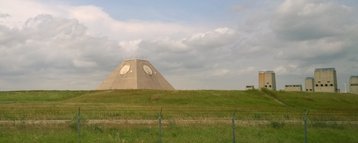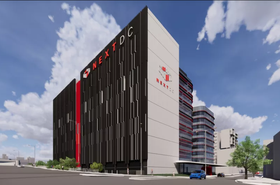Cryptocurrency mining firm Bitzero is to acquire a former missile base in North Dakota and convert it into a cryptomine data center.
North Dakota Gov. Doug Burgum this week announced that the Cavalier County Job Development Authority (CCJDA) has executed binding agreements with Bitzero Blockchain Inc. to acquire and redevelop the Stanley R. Mickelsen Safeguard Complex (SRMSC) at Nekoma, commonly known as “The Pyramid.”
After acquiring the site for a reported $250,000, Bitzero said it plans to invest up to $500 million developing the abandoned Cold War-era military installation into a data center for high-performance computing and data processing. Specifications weren't shared, but waste heat captured from the data center’s servers will be used to heat an on-site greenhouse.
“This is fantastic news for Cavalier County and our entire state, putting this iconic pyramid on the prairie to innovative use and further solidifying North Dakota’s status as a global hub for data center development,” Gov. Burgum said. “We are deeply grateful for Bitzero’s significant investment in our state and for the tireless efforts of the North Dakota Department of Commerce and Cavalier County Job Development Authority to secure a viable tenant and seize the potential of this historic structure. This important piece of history will be restored and become a beacon for North Dakota innovation to the rest of the world.”
Built as part of the US nuclear defense system during the Cold War, the site once housed & controlled anti-ballistic missiles. It became operational in April 1975 but was shuttered after only eight months, after Congress voted in October 1975 to deactivate the complex. The CCJDA has owned the site’s tactical area – the pyramid, adjoining underground power plant, and missile field – since 2017.
“The history of this site and the integrity of the community and leadership we have met here in Cavalier County are a marvel,” said Bitzero CEO Akbar Shamji. “The Pyramid when correctly understood is a monument to peace. The extraordinary capacity of the site in its first incarnation was a direct catalyst to the peace treaties of 1975 and the end of the Cold War. In its new incarnation the site will reappear again as a beacon for change in the now biggest challenge we face as society, climate change. The use of existing unutilized resources and ZCD energy at this site will guide the global data center industry and its stakeholders. Be they developers, users or shareholders, The Pyramid Data Centre will demonstrate for all concerned the increased functionality, lower cost of capital and higher profitability from harnessing natural energy and working in tandem with local communities and leading minds when approaching data services.”
Little information about Bitzero is available online. It claims to focus on renewable power for its own mining as well as the mining of hosted customers. Former Dragon’s Den/Shark Tank investor Kevin O’Leary and Dubai-based venture capital firm Phoenix Group are strategic advisors to the company. It appears to have a facility in Tunnsjødal, Norway, and is planning a 50MW hydroelectric-powered facility on reservation land in Polson, Montana.
In June, Bitzero announced North Dakota as the headquarters and hub for its North American operations, along with plans to build 200MW of data centers in North Dakota in the next two to three years
“The announcement from Bitzero to purchase 'The Pyramid’ is a great leap forward for North Dakota,” said Josh Teigen, director of Commerce’s Economic Development and Finance Division. “North Dakota leads the world in a variety of verticals whether it is our robust tech sector, autonomous farming, or unmanned aircraft systems, and expanding highly secure data center infrastructure in our state will help support all industries and diversify our economy. Bitzero’s announcement also brings together two pillars of our economy, energy, and agriculture, as all waste heat from the data center will be used in an on-site greenhouse to enable North Dakota to grow crops year-round and help feed the world."
Named after Stanley R. Mickelsen, a former commanding general of the US Army Air Defense Command, SRMSC supported the United States Army's Safeguard anti-ballistic missile program, providing launch and control for 30 LIM-49 Spartan anti-ballistic missiles, and 70 shorter-range Sprint anti-ballistic missiles to protect the nuclear Minuteman launchers based at Grand Forks Air Force Base in North Dakota. After being deemed ineffective by Congress, the complex was deactivated in February 1976, after less than a year of operation and 24 hours of full operational capacity.
The Spring Creek Hutterite Colony of Forbes, North Dakota acquired the site at auction in 2012, before selling portions of the property to the CCJDA in 2017.
The Missile Site Control Building (MSCB) contained the pyramid-shaped Missile Site Radar (MSR) and the underground data processing and command/control center. The only part of the original site still in use is the Perimeter Acquisition Radar (PAR) operated by the US Air Force operates as part of its space tracking and early warning system.






